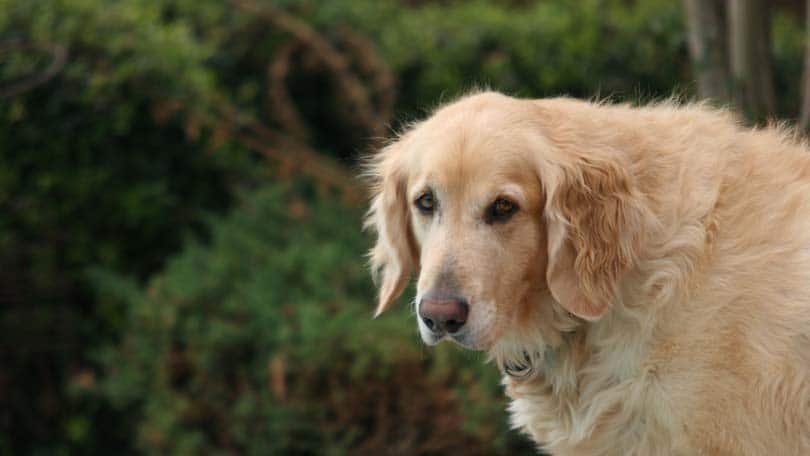Glaucoma in Dogs
The canine eye is a very complex structure. The inside of the eye is divided into two halves. The anterior chamber at the front is filled with a fluid called aqueous humor and the posterior chamber towards the back is filled with a jelly-like substance. The two halves are separated by the iris, pigmented tissue that can dilate and constrict surrounding the pupil and clear lens.
Cells within the eye continuously produce aqueous humor. To keep pressure within the eye steady, the fluid must drain out of the anterior chamber at the same rate that it is produced. The structure responsible for the outflow of aqueous humor is called the filtration angle. If more aqueous humor is produced than can flow out through the filtration angle, the pressure within the eye rises, leading to a painful condition called glaucoma. If pressures rise dramatically, the part of the eye that converts light into nerve signals (the retina) and the nerve leading away from the eye (the optic nerve) can be permanently damaged, resulting in blindness.
Glaucoma is classified as being either a primary or a secondary disorder. Primary glaucoma develops when a filtration angle fails to form properly. This part of the eye normally consists of many small holes through which aqueous humor can easily flow and be absorbed by nearby blood vessels. The filtration angle may have fewer holes than is normal or the passageway in front of the holes may be too narrow and restrict the flow of fluid. Other problems can exist as well.
Certain breeds of dogs are genetically predisposed to develop primary glaucoma, including cocker spaniels, basset hounds, chows, shar-peis, huskies, Boston terriers, samoyeds, dalmatians, poodles, shih tzus, and many others. Even though the eyes of a dog with primary glaucoma have been abnormal since puppyhood, symptoms tend not develop until they are older and rarely in both eyes at the same time.
If injury or disease causes pressures to rise in an otherwise normal eye, the condition is called secondary glaucoma. Infection and inflammation can cause abnormal cells, protein, and debris to collect within the anterior chamber and clog up; the filtration angle. Tumors inside of the eye or a lens that has fallen out of place may also block the flow of aqueous humor.
Symptoms
Whatever the cause, eye pressure can rise to dangerous levels very quickly so immediate veterinary attention is necessary if any of the following symptoms are noted:
- squinting and a reluctance to open the eyelids
- elevation of the third eyelid, a membrane that lies just under the outer lids and usually remains hidden
- abnormal redness to the eyes
- pain
- excessive tear production
- a dilated pupil that doesn’t constrict normally in bright light
- the clear surface of the eye becomes cloudy
- one eyeball is noticeably larger than the other
- impaired vision
Diagnosis
Other diseases can cause clinical signs that are similar to those of glaucoma. To uncover the cause of a dog’s symptoms, a veterinarian will start with a complete history and physical exam to determine the state of the pet’s overall health and whether or not a systemic disease could be to blame for the eye problems. In some cases, blood work or other diagnostic tests may be necessary. Next, the veterinarian will examine both eyes very closely, using an ophthalmoscope and sometimes other special equipment. The doctor may also test the dog’s level of tear production and stain the surface of the cornea to determine if any scratches, punctures, or ulcers are present. To test for glaucoma, the veterinarian will place some numbing eye drops in both eyes and then use one of several different types of instruments to determine how much pressure is pushing out against the cornea. Ophthalmologists also have the equipment and training necessary to directly examine the filtration angle, which is located where the outer edge of the iris attaches to the eye’s wall. If glaucoma is diagnosed, treatment will begin immediately.
Treatment and Prevention
A dog with severe and rapidly progressing glaucoma can lose sight in an affected eye within 12 to 24 hours. Emergency treatment of these cases can include eye drops, oral medications, and intravenous infusions all aimed at rapidly bringing eye pressures down to a safe level. Once the patient is stable, many general practitioners will refer glaucoma cases to a veterinary ophthalmologist for continued diagnosis and care.
Long-term treatment options for glaucoma include both topical and oral medications that reduce aqueous humor production, improve flow of fluid through the filtration angle, and decrease inflammation. Patients may require frequent doses of several different types of drugs to keep their eye pressures low. Determining which treatment is best always depends on the underlying cause of the glaucoma and the dog’s response to therapy.
If eye drops and oral medications aren’t effective, surgery is another option. Veterinary ophthalmologists can use lasers or extreme cold to destroy some of the cells that produce aqueous humor or implant tubes that drain excess fluid from the eye. For a blind eye, enucleation (the surgical removal of the eye) or an injection into the back of the eye that destroys all of the fluid-producing cells may be the best way to keep a dog suffering from glaucoma comfortable.
If a pet has developed primary glaucoma in one eye, chances are relatively good that similar problems will arise in the other eye at some point in the future. For this reason, many veterinarians will prescribe medications for both eyes from the offset to try to prevent an emergency situation with the dog’s good eye.
Prognosis
Many dogs with glaucoma require life-long treatment, close monitoring by their owners, and frequent rechecks with a veterinarian. Drug dosages and treatment protocols may need to be modified as a dog’s condition changes with time. Never discontinue or alter your dog’s medications without first speaking to a veterinarian. If you begin to see a return of glaucoma symptoms despite treatment, get your dog to the doctor immediately. Even if glaucoma has resulted in permanent vision loss, many blind dogs can still go on to lead full and satisfying lives.
Article By:
Jennifer Coates, DVM graduated with honors from the Virginia-Maryland Regional College of Veterinary Medicine in 1999. In the years since, she has practiced veterinary medicine in Virginia, Wyoming, and Colorado and is the author of several short stories and books, including the Dictionary of Veterinary Terms, Vet-Speak Deciphered for the Non-Veterinarian. Dr. Coates lives in Fort Collins, Colorado with her husband, daughter, and a menagerie of pets.

Having discovered a fondness for insects while pursuing her degree in Biology, Randi Jones was quite bugged to know that people usually dismissed these little creatures as “creepy-crawlies”.







